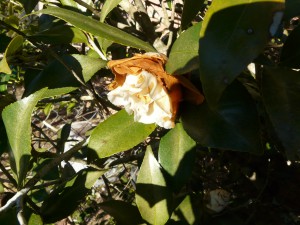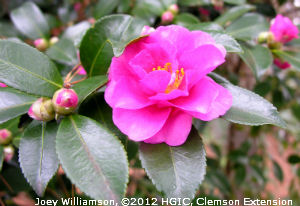
by Sheila Dunning | Nov 18, 2015
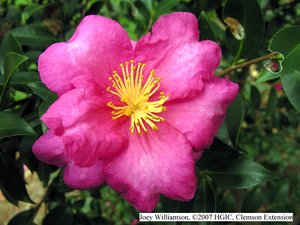
Camellia sasanqua ‘Kanjiro’ at the South Carolina Botanical Garden
Camellia sasanquas begin blooming this month. Their three-inch diameter blossoms of pink, white, rose or red displayed over glossy, dark green foliage will come into their full glory in November. This robust and stylish aristocrat of the garden is often passed by in favor of its familiar cousin, Camellia japonica. While it’s true that the “japonicas” have larger flowers, Camellia sasanqua has just as many endearing attributes. Like the japonicas, sasanquas have been selected and hybridized into dozens of forms that vary immensely in flower color, size and shape. With a variety of growth habits from dwarf and spreading to narrow and upright, their ability to thrive in part sun or shade, sasanquas are one of the most versatile landscape plants.
Sasanquas bear profusions of flowers in fall and early winter depending on cultivar and location. In general they blossom before Camellia japonica. Sasanquas have mature heights that range from 4-15 ft. The taller cultivars are typically trimmed up as small trees. Other cultivars remain shrubby and limited in height. Their small foliage makes them suitable subjects for formal pruning, although they are quite attractive when allowed to grow naturally. Several sasanqua varieties are ideal for creating dramatic espaliers when trained on fences and walls. Like other cool weather bloomers, sasanquas bloom over a much longer period than most spring and summer plants with buds opening over a three-month period. The blossoms shatter easily and create colorful carpets of petals on the ground, adding to their garden impact. Even when not in bloom the sasanquas make a statement with their beautifully glossy, rich green leaves that excel at providing backdrops for garden neighbors.

Camellia ‘Vernalis Yuletide’ at the South Carolina Botanical Garden

Camellia sasanqua ‘Shishi Gashira’ at the South Carolina Botanical Garden
Sasanqua camellias are native to China and Japan. They prefer rich organic acid soils (the same as azaleas and gardenias). Provide plants with organic mulch such as leaf litter or shredded bark. Broken shade is preferred but sasanquas will tolerate more sun if watered well. Consistent watering is important to continuous blooming. If the experience drought conditions the buds will dry and fall without opening.
Select sasanqua varieties based on what you want them to do in your garden. ‘Shishi-Gashira’ is a dwarf, low spreading plant that is suited well for foundation plants and container specimens. Other compact varieties include the more upright ‘Yuletide’ whose fiery red blossoms are accented with bright yellow stamens and the double rose ‘Bonanza’ which begins flowering in September with flowers that rival the japonica varieties in size and form. If you need larger and faster growing plants for hedges, screens or small specimen tree, consider the white ‘Snow on the Mountain’, double pink ‘Pink Snow’ or pale, shell pink ‘Jean May’. ‘Kanjiro’ and ‘Daydream’ are vigorous upright pink varieties whose single flowers are fragrant.
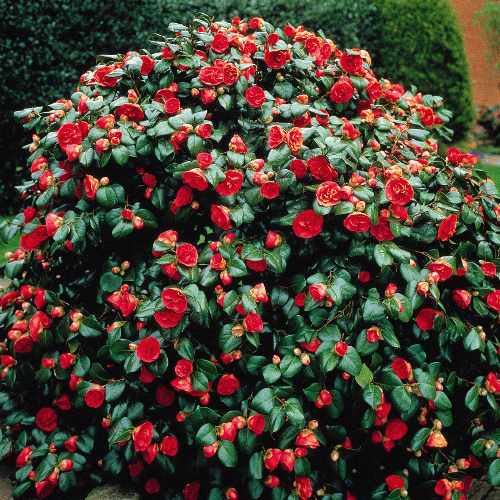
by Julie McConnell | Oct 15, 2015
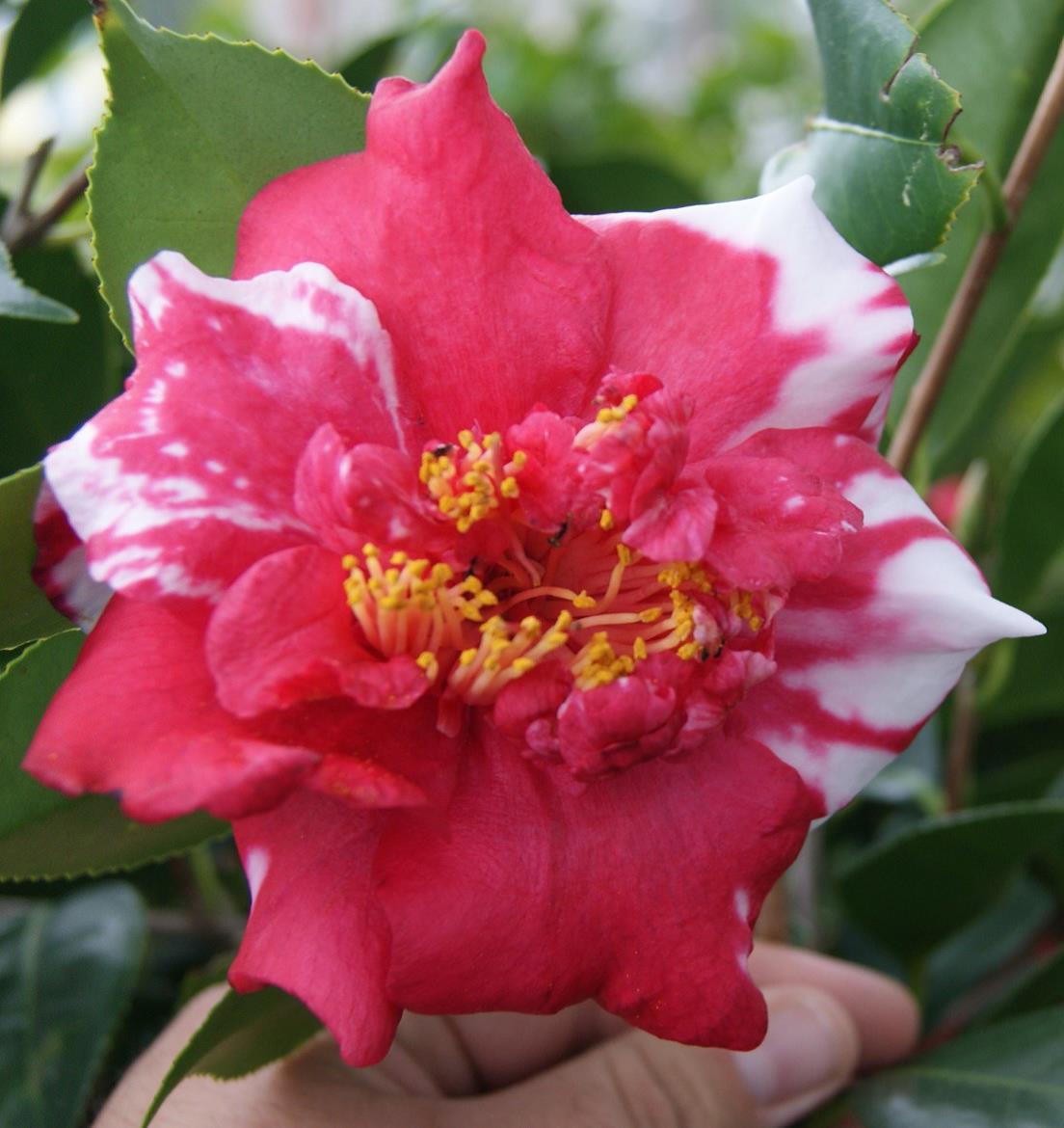
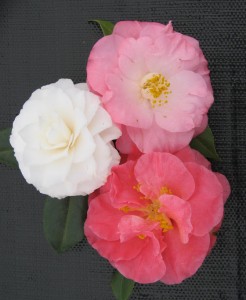
White by the Gate, Magnoliaeflora, and Spellbound camellia flowers
Are you looking for an evergreen shrub with showy flowers in the fall or winter? Look no further than an old Southern favorite, the camellia.
Large camellias dot landscapes of historic homes throughout the Florida Panhandle, and although they look like they’ve been here forever.
Camellias are not native to North America, but were originally brought here from Asia in 1797. There are many different types, but the most common camellias found in Florida are Camellia sasanqua which bloom in the fall (October – December) and Camellia japonica with larger leaves and a later bloom time of January through March. Some other types of camellias are Camellia reticulata, C. hiemalis, C. vernails and their hybrids; and Camellia sinensis is the source of tea which is made from the young leaves of this plant.
Flower colors range from a crisp white to a deep crimson and there are even some cultivars with variegated flowers! There are six recognized flower forms and they are single, semi-double, anemone, peony, formal double, and rose form double. Although most camellias have the potential to get over ten feet tall and five feet wide, there are some that grow slower and can be maintained at lower heights. Camellia sasanqua ‘Bonanza’ and C. sasanqua ‘Shishi Gashira’ have more horizontal branching habits and can be kept under five feet tall, however they will need more width than a more upright growing camellia.
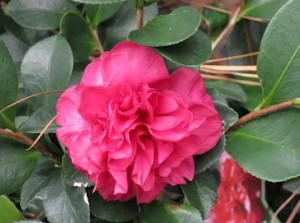
Camellia sasanqua ‘Bonanza’
When choosing a site for your camellia, look for an area with light shade, good air flow, and well-drained soil. Test your soil to determine pH and fertilizer needs before planting; soil testing kits can be picked up at your local county extension office. Camellias prefer acidic soil with a target pH range of 5.0 to 6.5, and benefit from organic matter amendments in sandy soil. Plant camellias slightly higher than the natural grade; dig a hole that is wide and shallow. After planting check that the top of the root ball is one to two inches above the soil line to allow for some settling. Mulching helps to conserve moisture and regulate soil temperatures, but be careful not to cover the root ball with thick mulch layers.
For more information about camellias and their care in Florida, please see Camellias at a Glance at http://edis.ifas.ufl.edu/pdffiles/EP/EP00200.pdf .
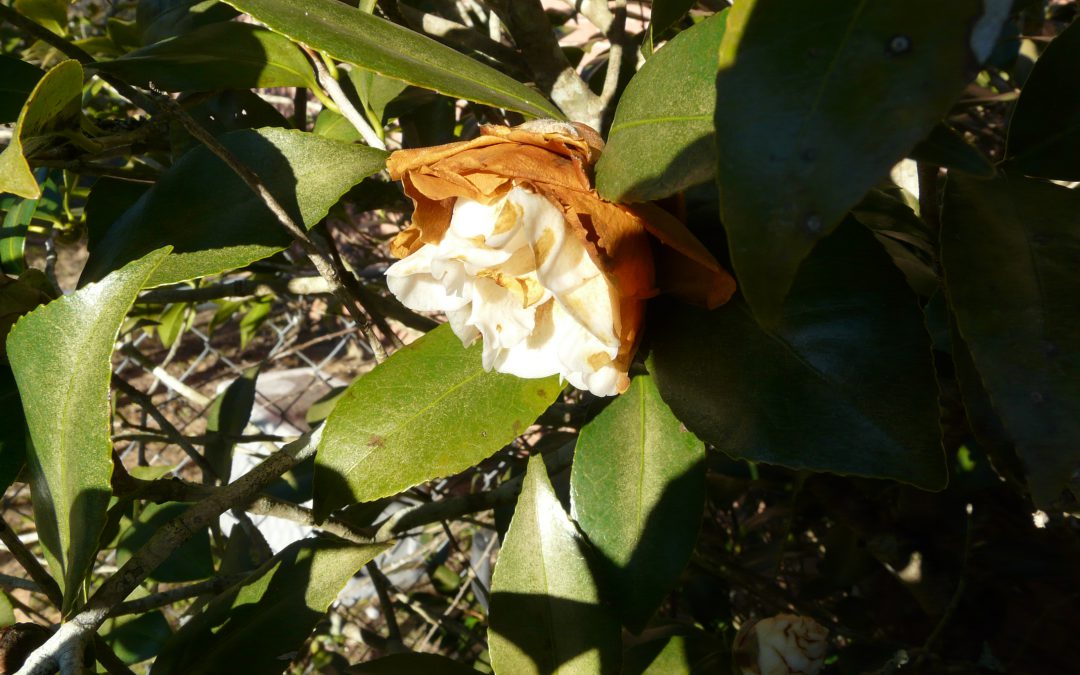
by Larry Williams | Jan 27, 2015
Do you have camellia plants with flower buds that fail to open? Here are possible causes for this problem.
For more information on camellias, contact the UF/IFAS Extension Office in your County or visit http://edis.ifas.ufl.edu/ep002 to access the publication, “Camellias at a Glance.”
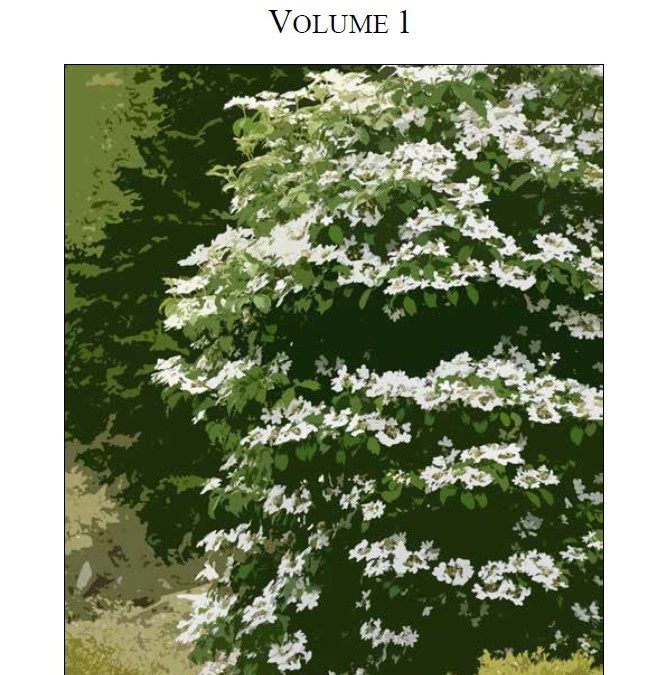
by Gary Knox | Aug 19, 2014
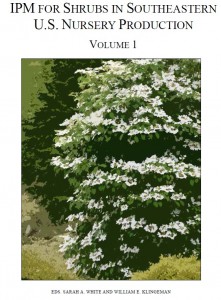 A new IPM guide is making it easier to grow five common southeastern shrubs. Growing five southeastern shrubs is now easier thanks to a free, new IPM resource from the Southern Nursery IPM Working Group.
A new IPM guide is making it easier to grow five common southeastern shrubs. Growing five southeastern shrubs is now easier thanks to a free, new IPM resource from the Southern Nursery IPM Working Group.
IPM for Shrubs in Southeastern U.S. Nursery Production is a compilation of Integrated Pest Management (IPM) information for five major shrubs in nursery crop production in the southeast. This 175 page book covers sustainable management for insects, mites, diseases, and weeds for these shrubs, as well as nursery production information. This IPM resource was developed for nursery growers although professional landscape managers and collectors of these plants also will find the information valuable.
Individual chapters cover abelia (Abelia spp.), camellia (Camellia spp.), shrub rose (Rosa spp.), blueberry (Vaccinium spp.) and viburnum (Viburnum spp.). Each chapter provides comprehensive information on the species, primary cultivars and their nursery production. Major pests, diseases, weeds and abiotic disorders are presented for each genus along with sustainable management methods and tables listing labeled pesticides and fungicides by mode of action and site. An additional chapter discusses weed management in shrub production. Future volumes covering additional shrubs are anticipated.
Edited by Clemson University’s Sarah A. White and University of Tennessee’s William E. Klingeman, this free guide was developed by the Southern Nursery IPM Working Group, including University of Florida NFREC’s Gary Knox and Mathews Paret. The award-winning, multi-disciplinary group is composed of experts from universities across the southeast. This group formed in 2008 to develop and deliver educational programming to the southern U.S. nursery industry and Extension personnel. The team recently won the 2014 Bright Idea Award from the Friends of Southern IPM and Southern IPM Center.
This resource joins the tree IPM book previously released by this group, IPM for Select Deciduous Trees in Southeastern US Nursery Production. The tree IPM book is similar to the new resource in that it contains IPM information for insects, mites, diseases, and weeds of nine major tree crops as well as production information. Individual chapters cover birch (Betula spp.), cherry (Prunus spp.), crapemyrtle (Lagerstroemia spp.), dogwood (Cornus spp.), chinese elm (Ulmus parvifolia), magnolia (Magnolia spp.), maple (Acer spp.), oak (Quercus spp.) and redbud (Cercis spp.).
Both books can be downloaded free through iTunes (http://www.apple.com/itunes/) or each chapter is available as a free pdf through the Southern Nursery IPM Working Group website, http://wiki.bugwood.org/SNIPM. A limited number of hardcopy books were printed and distributed to authors. Thanks to the Southern Region IPM Center for their generous support to make this resource possible!
by Matthew Orwat | Jan 27, 2014
Recently, I was working on a camellia identification project in a forgotten camellia garden of about 60 plants. Most camellias I observed were not yet in flower but one in particular caught my eye. I later identified this eye catcher as Camellia japonica ‘Magnoliaeflora’.
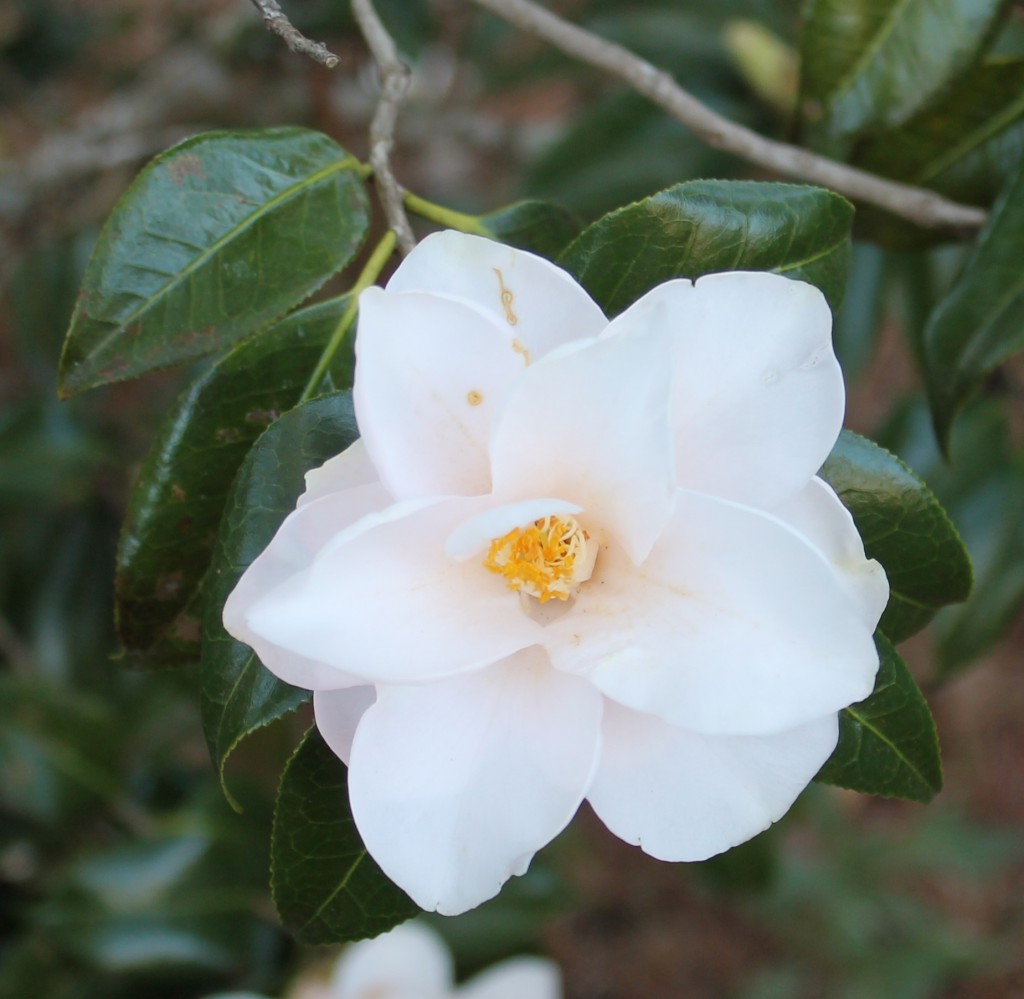
Flower of Camellia japonica ‘Magnoliaeflora’
Image Credit Matthew Orwat
Magnoliaeflora is so named due to its off white magnolia formed semi-double flowers. It’s petals have a distinctive curl and can sometimes resemble a star. Plants are slow-growing but can reach six feet tall and four feet wide after several decades. This slow growth makes it ideal for smaller landscapes where some giant japonica cultivars would be out-of-place.
Its buds and flowers are resistant to cold temperatures, thus flowering is able to occur in mid January, a tad earlier than many other japonicas. This classic camellia should be tried in more Northwest Florida landscapes, particularly newer ones where camellias seem all but absent.
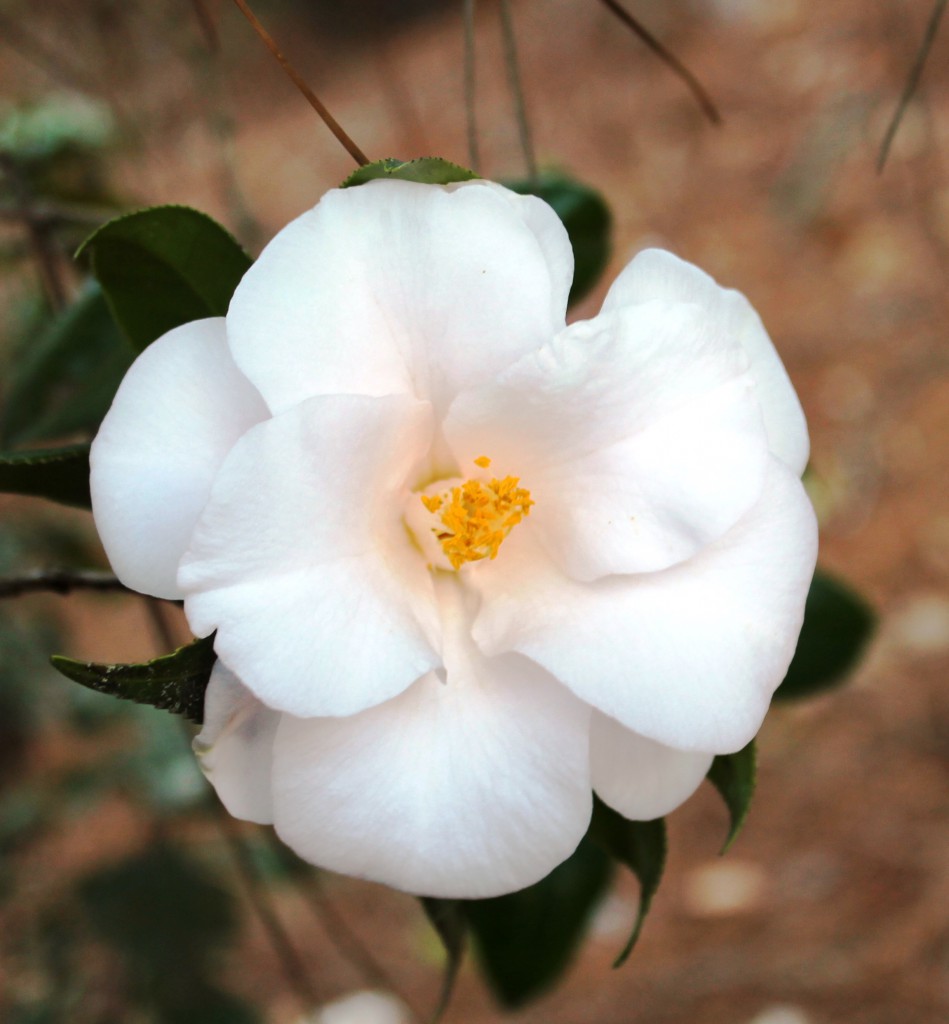
Flower of Camellia japonica ‘Magnoliaeflora’
Image Credit Matthew Orwat









